December 13, 2019
Air Date: December 13, 2019
FULL SHOW
SEGMENTS
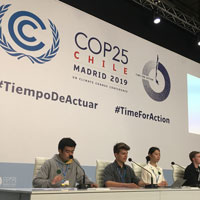
Democrats "Still In" at Madrid Climate Talks
/ Aynsley O'NeillView the page for this story
The latest UN climate talks, known as COP25, just wrapped up in Madrid, Spain. And in the wake of Republican President Trump officially beginning the process to pull the U.S. out of the Paris Agreement, a new vanguard of U.S. Democratic politicians with a climate agenda is saying “We Are Still In”. Speaker of the House Nancy Pelosi (D-CA) led a delegation of Democratic members of Congress, and Democratic Presidential candidate and former UN Special Climate Envoy Michael Bloomberg spoke about the “America’s Pledge” initiative. Living on Earth’s Aynsley O’Neill reports on the U.S. presence at the Madrid climate talks and on the debate over using carbon markets to curb global emissions. (05:38)
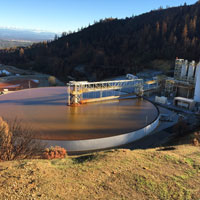
Climate and Superfund Sites
View the page for this story
The U.S. has more than 1,300 Superfund sites, areas contaminated with toxic substances, and the Environmental Protection Agency is responsible for overseeing their cleanup. But a recent study conducted by the U.S. Government Accountability Office found that cleanup efforts at 60 percent of Superfund sites could be compromised by climate change disasters such as flooding, fires, and hurricanes. Alfredo Gomez, the Director of Environmental Protection at the GAO, joined Host Steve Curwood to discuss this study and the recommendations the watchdog agency made to the EPA to protect Superfund sites from the impacts of climate change. (06:03)
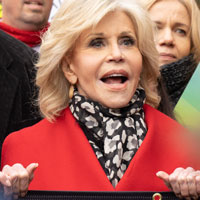
Jane Fonda and Climate Civil Disobedience
View the page for this story
Jane Fonda has been a Hollywood icon for a half-century, is a two-time Academy Award winner, and is currently starring in a hit Netflix show. But in 2019 she wants you talking about the climate. She’s spearheading the “Fire Drill Fridays” protests and, at 81 years old, even spent a night in jail for acts of civil disobedience in these efforts. Famous friends from Ted Danson to Sam Waterston to Diane Lane have joined her in risking arrest and using their celebrity to focus attention on the climate crisis. Jane Fonda joins Host Steve Curwood to discuss her activism and her call for more acts of civil disobedience to confront the planet’s warming. (20:57)
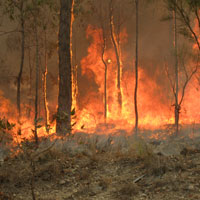
Beyond the Headlines
/ Peter DykstraView the page for this story
This week, Peter Dykstra and Host Steve Curwood discuss the impacts of climate-driven drought, from a fire that’s raging outside Sydney, Australia, to the rapid depletion of Bali’s water supply, to the reduction of Victoria Falls to a trickle, to the drying up during the ski season in parts of the Alps. They also mark the murder of two more indigenous environmental activists who protested logging in the Brazilian Amazon. And in the history calendar, they look back twenty years to Julia Butterfly Hill’s two-year tree sit protest. (04:26)
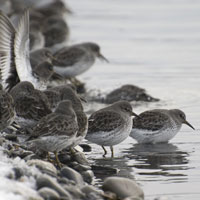
BirdNote®: Rock Sandpipers Are Tough
/ Mary McCannView the page for this story
Homer Spit on the southern tip of the Kenai Peninsula in Alaska is home to a colony of small shorebirds known as rock sandpipers, as well as gulls and waterfowl. One way to keep track of them is the yearly Christmas Bird Count. BirdNote's Mary McCann has more. (01:49)

A Preschool Christmas Bird Count
/ Bobby BascombView the page for this story
Susan Edwards Richmond’s new children’s book, Bird Count, follows a young citizen scientist as she participates in a Christmas Bird Count, the 120-year-old census of winter birds conducted by teams of volunteers for the Audubon Societies. Living on Earth’s Bobby Bascomb visited the author and the preschoolers she teaches at Massachusetts Audubon's Drumlin Farm for a day of birding, and a discussion on the importance of citizen science. Hijinks, and a whole lot of learning, ensued. (07:42)
Show Credits and Funders
Show Transcript
HOST: Steve Curwood
GUESTS: Jane Fonda, Alfredo Gomez, Susan Richmond
REPORTERS: Bobby Bascomb, Peter Dykstra, Mary McCann, Aynsley O’Neill
[THEME]
CURWOOD: From PRX – this is Living On Earth.
[THEME]
CURWOOD: I’m Steve Curwood.
Inspired by Gandhi and Martin Luther King, Jr., actor and climate activist Jane Fonda is leading Fire Drill Friday protests at the US Capitol.
FONDA: Unprecedented numbers in the streets are what it’s going to take. So, I thought, ok if there’s a crisis looming, then Jane Fonda, with a hit series behind her -- the least I can do is role model the next step, which is civil disobedience.
CURWOOD: Also, the annual Christmas Bird Count, with preschool children.
RICHMOND: Friends! Come over here, I see some birds on trees! Hard to tell what they are . . . big black birds.
LEO: Crows!
RICHMOND: They could be crows, Leo, I think they’re big for crows.
KID: I think they’re a kind of hawk.
CURWOOD: That and more this week on Living on Earth – Stick around!
[NEWSBREAK MUSIC: Boards Of Canada “Zoetrope” from “In A Beautiful Place Out In The Country” (Warp Records 2000)]
[THEME]
Democrats "Still In" at Madrid Climate Talks
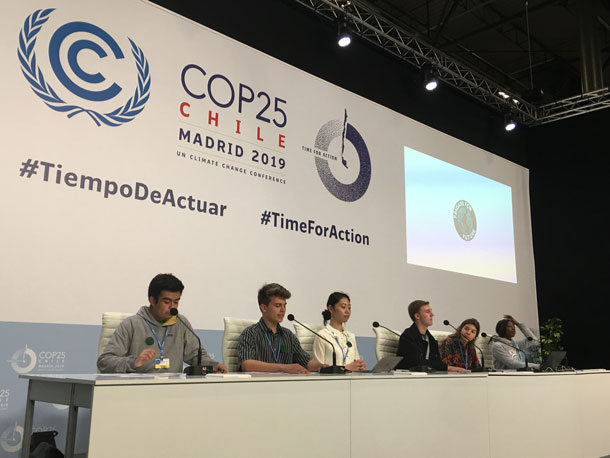
The 25th Conference of the Parties featured panels throughout two weeks of meetings, including this one with student activists from the Fridays for Future movement. (Photo: John Englart, Flickr, CC BY-SA 2.0)
CURWOOD: From PRX and the Jennifer and Ted Stanley Studios at the University of Massachusetts Boston, this is Living on Earth, I’m Steve Curwood.
You may recall that back in 2015, some 196 parties under the UN including the United States, adopted the Paris Climate Agreement, with the aspirational goal of limiting the increase in global temperature to 1.5 degrees centigrade, or at worst, to 2 degrees centigrade to avert climate catastrophe. But the pledges made at the time fell far short of that goal. So nations also agreed to meet yearly to refine the rules and boost ambition, so that by 2020 the world would be on track to protect a livable climate. The most recent round of talks gathered in Madrid, Spain for the 25th Conference of the Parties, also known as COP25, and Living on Earth’s Aynsley O’Neill has more.
O’NEILL: The United States is in an odd position at the Madrid negotiations.
It’s the only nation to give notice of intent to withdraw from the international agreement, although that won’t actually go into effect until the day after the 2020 election.
But a delegation of top Democrats including Speaker of the House, Nancy Pelosi, and several Democratic members of the US Congress, attended the COP in Madrid to communicate one message: that many Americans still support the Paris Agreement.
As current House Speaker, Nancy Pelosi is the highest-ranking member of the Democratic Party, and she’s the second person in the presidential line of succession.
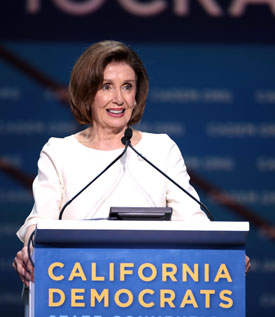
The US Congressional delegation was led by Nancy Pelosi, who as the current Speaker of the US House of Representatives, is the highest-ranking member of the Democratic party. (Photo: Gage Skidmore, Flickr, CC BY-SA 2.0)
She made it known that the congressional delegation’s decision to visit Madrid, even during the impeachment proceedings, showed their commitment to combating the climate emergency.
PELOSI: We’re still in to protect our environment for our children and their future. We’re in because it’s a public health issue: clean air, clean water, food safety. That it’s an economic issue about good-paying green jobs in our economy and throughout the globe. It is a security issue, in terms of natural disasters and the rest, robbing communities of habitat and natural resources, which can, in competition for such things, can cause conflict. And, it is a moral issue.
O’NEILL: Democratic presidential candidate Michael Bloomberg also attended the meeting.
Many consider climate change to be Bloomberg’s defining international issue, one he has been working on as both a politician and a philanthropist.
Mr. Bloomberg attended several UN climate change conferences as the UN’s special envoy for cities and climate change. And he’s donated hundreds of millions of dollars to various environmental causes.
But at this conference, he spoke of his America’s Pledge initiative.
It’s a group of cities, states, and organizations who have all pledged their commitment to the Paris climate goals, despite the Trump Administration’s decision to pull out of the Agreement.
BLOOMBERG: America's Pledge represents 68% of American Gross Domestic Product, 65% of the US population, and more than half of US emissions. Put that another way, if we were our own country, we would have an economy larger than China's or any other nation in the world, except the entire United States itself.
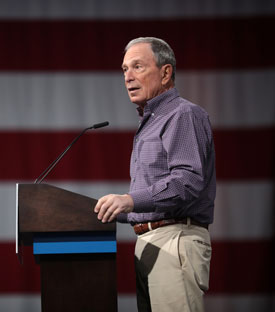
Michael Bloomberg, the former Mayor of New York City who recently announced he was running for president, presented his America’s Pledge report at the Madrid COP. (Photo: Gage Skidmore, Flickr, CC BY-SA 2.0)
O’NEILL: Mr. Bloomberg also talked about what’s missing from federal climate policy, and he tried to assure allies in the fight against climate change that the President’s decision to pull out of the Paris Agreement does not reflect the will of most Americans.
BLOOMBERG: So today, I ask that regardless of what you hear out of Washington, you should know that the American people support our Paris goals. We continue to work to meet them. We're making encouraging progress. We're looking forward to this November's election and a new president in 2020. We have to have America as part of the solution.
O’NEILL: The delegates at the conference spent about two weeks working towards climate solutions, but negotiations were, as always, difficult.
Countries tried to balance their national interests with their climate goals.
Activists struggled to make their voices heard, and fossil fuel companies held events, typically focusing on the carbon market.
The carbon market allows industries to emit greenhouse gases but they must first buy and sell the right to do so.
The idea is to gradually increase the cost and decrease emissions over time.
Lidy Nacpil, a climate activist from the Philippines, critiqued the concept of carbon trading, saying that rather than creating an incentive for reducing emissions, it instead allows the responsible parties to avoid accountability.
NACPIL: Carbon trading and carbon markets have made governments and corporations very complacent about pledging and especially about delivering on their targets. They have used this as a mechanism to shove their responsibilities to other countries and use money in order to avoid actual effective delivery of mitigation actions.
Lidy Nacpil on the panel “Friends of the Earth International and Allies: Civil Society Comment on Carbon Markets in the Negotiations”.
O’NEILL: The COP was attended by delegates from around the world, with a goal to create firm targets and ratchet up ambitions.
But top scientists have said that UN climate talks are falling short of what we need to avert the worst effects of the climate crisis.
India appears to be the only major world economy that is “2 degree compatible”.
And only a small fraction of countries are on track to meet their Paris goals.
The world is now looking ahead to the 2020 UN climate summit in Glasgow, Scotland, which is set to be the most crucial climate talk since Paris in 2015.
Scientists warn that if emissions continue to rise through the year 2030, it will be too late to reverse or even slow the effects of climate change.
With the 2020 Glasgow conference a mere decade before that deadline, many see it as the last chance to take truly effective action on the climate crisis.
For Living on Earth, I’m Aynsley O’Neill.
Related links:
- See more from the 25th UN Climate Change Conference
- Click here to watch Speaker Nancy Pelosi’s statement on the Madrid COP
- Click here to see Michael Bloomberg present the latest America’s Pledge report at the Madrid COP
[MUSIC: Kemi Akanni, “Omo” on African Lullaby, by Kemi Akanni, Elipsis Arts]
Climate and Superfund Sites
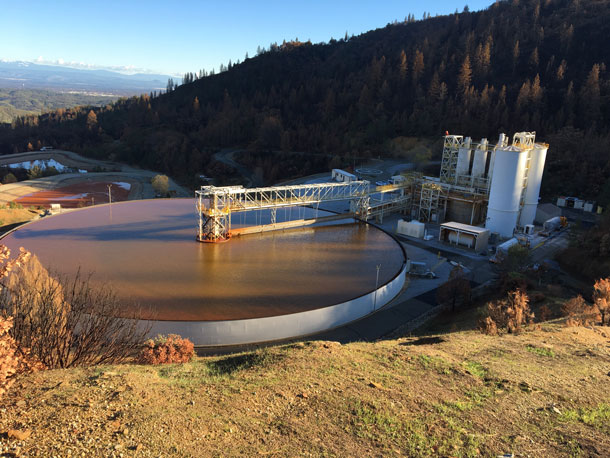
The Iron Mountain Site near Redding, California is one of the three sites the Government Accountability Office physically tested for this study. This photo shows a partially constructed water treatment system by Aventis, the company responsible for contamination at the site. This water treatment system captures the acid mine drainage, neutralizes it, and removes metals prior to discharge. (Photo: Courtesy of GAO)
CURWOOD: Back in 1980 in the wake of the toxic dumping scandal at Love Canal, in upstate New York, Congress enacted a law that forced industry and property owners to cleanup places containing hazardous materials. And if there were no identifiable owners, Congress created a Superfund to set aside taxes to pay for such cleanups. Forty years later there are more than fifteen hundred Superfund places in the US, in the form of industrial sites, landfills, abandoned mines and military bases, all loaded with substances hazardous to human health. The Environmental Protection Agency is in charge of cleaning them up and remediating the dangers, and now the risks include climate change. The Government Accountability Office recently found more than half of these toxic waste sites are vulnerable to the effects of climate disruption, including wildfires, hurricanes, sea level rise, and flooding. Alfredo Gomez is director of Environmental Protection at the GAO, and led the study. Alfredo Gomez, welcome to Living on Earth.
GOMEZ: Thank you for having me.
CURWOOD: Now, from my understanding, you folks physically tested some of these sites. Where were these located? And what did you find?
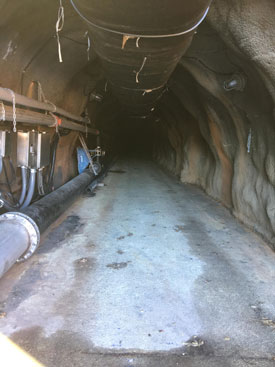
In 2018 there was a California fire that almost destroyed the Iron Mountain site water treatment system. During that fire season, polyethylene pipes that carry acid drainage from one of the mines to the water treatment system were partially replaced with nonflammable stainless-steel pipes. If fire were to reach the body of the mine, there could be an explosion and various environmental health hazards. (Photo: Courtesy of GAO)
GOMEZ: We specifically visited three sites. We visited a site in the Houston area, we visited a site in Northern California that was a former mining site, and then we also visited a former industrial site in New Jersey. So we wanted to look and see what was happening at that site, what the cleanup is, what are the potential climate impacts. And in our report, for example, we talk about the mining site in California, that the officials there at EPA have told us that they're very concerned about wildfire risk. The recent wildfire there destroyed part of the site, their water treatment system that was treating acid drainage from the mine was almost affected by the wildfire. And so those are the kinds of things that we were hoping to do in this report was to bring attention to what are the potential climate effects and what may be at risk at the Superfund sites.
CURWOOD: So in 2017, Hurricane Harvey hit the Greater Houston area that had several Superfund sites. You tested one of those sites, what exactly were the substances you found there? And how much of the stuff there seemed to get out in the environment?
GOMEZ: Yes. So the Houston area, as you noted, was really affected by Hurricane Harvey. They had unprecedented flooding throughout the area. And one of the Superfund sites that we looked at in particular and visited was the San Jacinto river waste pit site, and that is a site that has past contaminants, primarily dioxins and furans. And because of the flooding that took place there, it dislodged the cap that sits at the site, and it actually released dioxins throughout the area and once EPA did testing it did find high levels of dioxin in the area. And dioxin has been shown to have adverse effects to health, for example, it does cause liver damage and certain cancers. So those are the things that are a potential risk to not only public health, but also the environment.
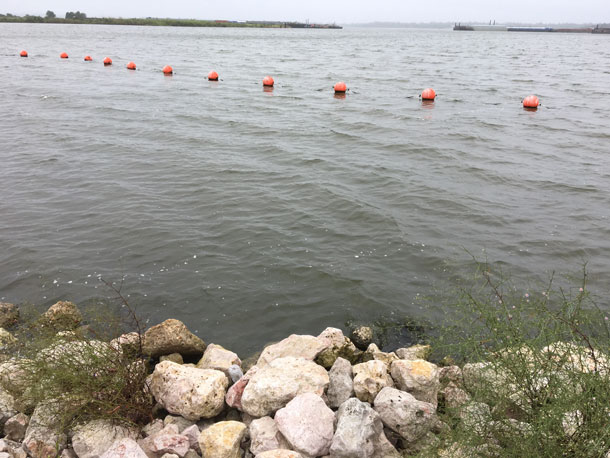
The San Jacinto River Waste Pit site located in Houston Texas is contaminated with dioxins and furans, exposure to which can cause several health effects including skin diseases and liver damage. This site is in an area that has 1 percent or higher annual chance of flooding that may be impacted by storm surge during Category 1 hurricanes. In 2017 Hurricane Harvey flooded this site exposing some of the contaminated material. (Photo: Courtesy of GAO)
CURWOOD: What level of concern did you find in these areas where you were testing, both by the government agencies that are in charge of this but also in the community?
GOMEZ: So there is concern from government agencies. In the Houston area, we talked to community representatives who have been concerned about proper treatment of the contaminants at that waste site. So for example, in the San Jacinto River site, the EPA has asked the responsible party now to dredge the contaminated soil and treat it off site because of the concern of future flooding at the site that might continue to disperse it.
CURWOOD: So I gather that the Government Accountability Office has made several recommendations now to the Environmental Protection Agency in the wake of this study, what were those recommendations?
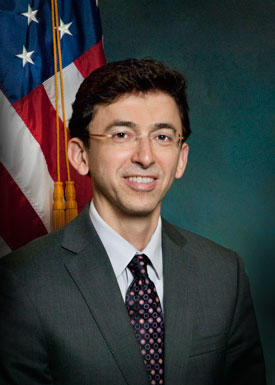
Alfredo Gomez is Director of the Natural Resources and Environment at the U.S. Government Accountability Office, an independent non-partisan agency of the US Congress. (Photo: Courtesy of GAO)
GOMEZ: Yes, the first recommendation we made was that EPA needed to develop a schedule to better define the boundaries of the Superfund sites. So currently, we don't have complete information or accurate information on the actual boundaries of the sites. And part of the reason is because contamination can migrate. So for example, if the groundwater is contaminated and there is a plume, that plume can move, and so contamination can be dispersed. So that was the first recommendation we made. EPA agreed to continue working on developing better and complete information for the boundaries of the Superfund sites. We made three additional recommendations, which the agency disagreed with. Two of those recommendations are sort of similar. We recommended that EPA provide information to all of its regional offices, which is where the work is taking place to help people incorporate information on climate change impacts into their risk assessments, but also into their risk management decisions. The last recommendation was making sure that EPA is aligning the actions that are taking place, for example, at the regional offices with all the way up to the highest levels of the Superfund program. And what we talked about is that in the current strategic plan for EPA, they don't mention climate change. We wanted to make sure that there is consistency across EPA, and that everyone is able to have the information that they need to better plan for the future.
CURWOOD: Alfredo Gomez is the director of Environmental Protection at the Government Accountability Office. Thank you so much for taking the time with us today.
GOMEZ: Thank you for asking me to be a part of your show.
Related links:
- Eco Watch | “945 Toxic Waste Sites at Risk of Disaster from Climate Change”
- The Salt Lake Tribune | “GAO: 60 Percent of Superfund Sites at Higher Risk in Climate Change”
- Click here to read GAO’s report and interactive map
[MUSIC: Joshua Rifkin, “Solace – A Mexican Serenade” on Scott Joplin Rags, by Scott Joplin, Nonesuch Records]
CURWOOD: Coming up, activist actor Jane Fonda on using her celebrity to promote civil disobedience in the fight against climate change. That’s just ahead on Living on Earth.
ANNOUNCER: Support for Living on Earth comes from Sailors for the Sea and Oceana. Helping boaters race clean, sail green and protect the seas they love. More information at sailors for the sea dot org.
[CUTAWAY MUSIC: Joshua Rifkin, “Solace – A Mexican Serenade” on Scott Joplin Rags, by Scott Joplin, Nonesuch Records]
Jane Fonda and Climate Civil Disobedience
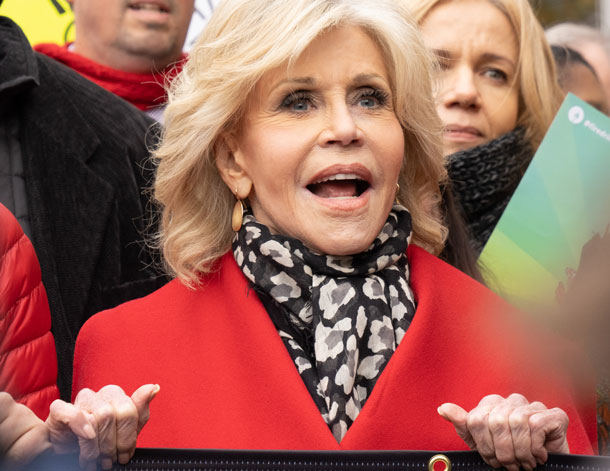
Jane Fonda, even at 81, has been out on the streets of Washington, DC at Capitol Hill every Friday from October to December, protesting inaction on the climate crisis. (Photo: Victoria Pickering, Flickr, CC BY-NC-ND 2.0)
CURWOOD: It’s Living on Earth, I’m Steve Curwood.
Born the daughter of Hollywood star Henry Fonda, Jane Fonda has won two Oscars, seven Golden Globes and the American Film Institute’s lifetime achievement award. She got started on Broadway in 1960, and today she stars in the Netflix series ‘Grace and Frankie.’ But Jane Fonda may be even more famous as an activist, beginning with her protest of the Vietnam War and including her hilarious satirical sendup of sexism in the 1980 movie 9 to 5, where she appeared with Lily Tomlin and Dolly Parton. Now, at 81, she is back at it, this time protesting the lack of climate action on Capitol Hill.
[PROTEST SOUNDS]
CROWD: What do we want? Climate justice! When do we want it? Now!
CURWOOD: Each Friday since October, Jane, along with an army of volunteers, activists, and celebrities, block Capitol buildings and refuse to move when police ask them to leave.
[CROWD CHANTING]
POLICE: If you do not move from the area you will be arrested.
CURWOOD: Jane has been arrested four times and in November spent a night in jail for the first time since her Vietnam protest days back in the 70s. Now when police close in she leaves, as her record and bail conditions would land her back in jail for as many as 90 days, but others with less risk continue to get arrested at the sit-ins. She joins me now to discuss her message and her mission. Jane Fonda, welcome to Living on Earth!
FONDA: Thank you for having me.
CURWOOD: Our pleasure. So in your own words, what are these Fire Drill Friday protests, tell me about the teach-ins that go along with them?
FONDA: Well, I wanted to do something more than I had been doing. I knew the climate crisis is looming, and I decided to put my body on the line and leave my comfort zone and move to DC, and I called Annie Leonard who is the director of Greenpeace USA to help me, and a number of other people in DC who are used to holding protests in DC are working with me. We decided to have an action every Friday, because that's when Greta Thunberg and the student climate strikers are having it. We've claimed Friday and they have, I asked their permission first, and they welcomed me to their Friday protests. And I speak at theirs, and they speak at mine. And I wanted these actions to be teach-ins. But we realized that you can't really, it's hard to go deep at an outdoor rally, so every Thursday evening at seven o'clock Eastern time, we have a proper teach-in where scientists and experts and frontline community representatives go in-depth into the issues, every Friday we focus on a specific issue. For example, this Friday it's going to be migration and human rights. It's been forests, women, oceans, the Green New Deal and so forth. And we speak at length and it lasts about an hour and then we engage in civil disobedience and risk getting arrested.
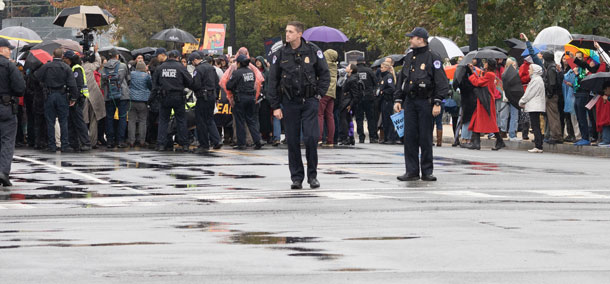
Fire Drill Friday protestors surrounded by police. (Photo: Victoria Pickering, Flickr, CC BY-NC-ND 2.0)
CURWOOD: What inspired you to start the Fire Drill Friday protests?
FONDA: The young student strikers and Greta Thunberg. You know, Greta, she said we have to leave our, our comfort zones and, and do more. I had been doing all the personal individual things -- you know, like driving an electric car and cutting way back on meat and getting rid of single use plastics, but I knew that, while those are important and they're good starting places, it's not the place to stop, that you have to do more. And, you know, I just wondered, well, what, what can I do as a celebrity that will make a difference and Greta was the one that really motivated me to move to DC and engage in civil disobedience. Historically, civil disobedience is a, a noble thing that has changed history, both here in the United States because of the Southern movement, Martin Luther King, the sit-ins at the lunch counters, you know, the bus boycotts, Gandhi and India winning freedom from British colonialism through his nonviolent civil disobedience. It can change things. It changes you as an individual and it can change policy. I recently met with the Senate Task Force on Climate Change. And I said, is there something more or different that I should be doing and they said, do what you're doing, build an army! Make it bigger! We need that pressure from the outside.
CURWOOD: Well, your name is Jane Fonda and so when you do something a lot of us pay attention. How does that feel?
FONDA: I feel very blessed that I have a platform that I have, and a hit TV series Grace and Frankie that, you know, that boosts that platform so that people will pay attention. But I, the important thing is sharing the platform I, I make sure that the people that are standing on that stage with me every Friday and are at the teach-ins on Thursday, are very, very diverse, people who don't often get a big platform for their voices, people from frontline communities, from Lowndes County, Alabama, from a farmer from Wisconsin was there last week, a fisherperson from Maine. We, we try to bring people who don't often have a platform, but who are in the front lines of the climate crisis, who, who are the most impacted. But then we also have scientists who speak to us and people say they're really learning a lot and selfishly, I wanted to do this because I want to learn a lot too. And I am.
CURWOOD: Of course. Now, you've been involved in protesting various issues, going back, what, to the Vietnam War, feminist advocacy, of course environmental activism for all these years. So to what extent does the Fire Drill Friday activism, feel different from those other campaigns?
FONDA: Well, everything is different now. Because we, we've never faced this kind of, of urgency. You know, those of us who have been studying the issue, like you have of climate crisis, realize that it is a real catastrophe. That's what the scientists are telling us: wake up people. It is dire. We have very, very little time to do a truly Herculean task, which is to wean ourselves off of fossil fuel. We have to stop all fossil fuel expansion immediately, so it doesn't make things worse, and then wean ourselves off. By the middle of the century, we have to be totally off fossil fuels. But we have to cut our fossil fuel use in half in the next decade, that's very, very difficult. And we all have to be part of this incredible effort. And the only way to do it is by people in huge unprecedented numbers, mobilizing in the streets and pressuring our governments. And what's so interesting to me is that's what the scientists are telling us. Unprecedented numbers in the streets are what it's going to take. So you know, I thought, okay, if there's a crisis looming, and we only have a decade, then Jane Fonda, with a hit series behind her, the least I can do is role model the next step, which is civil disobedience.
CURWOOD: So how have you or those you love been affected by the disruption in our climate system?
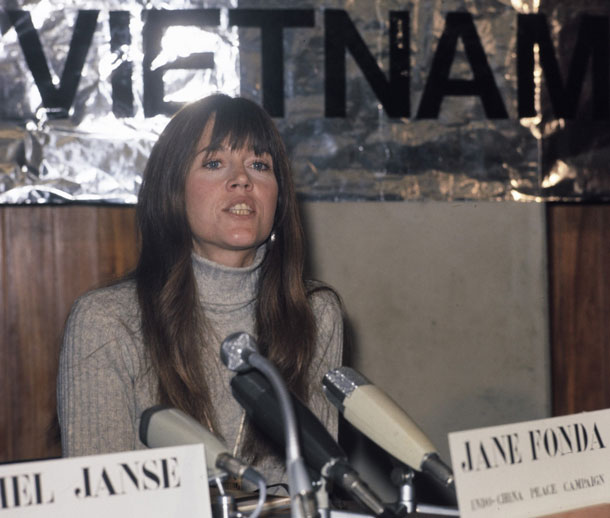
Jane Fonda has been an activist for numerous issues for quite a while, and was involved in protests against the Vietnam War, even being arrested on trumped up charges during a speaking tour against the war in 1970. (Photo: Mieremet, Rob / Anefo on Wikimedia Commons, Public Domain)
FONDA: Well, on a very personal level, I grew up in California. I was born in 1937, there were only 2 billion people on Earth. It's very, very different now, 8 billion people, that changes everything. And because of air pollution and extreme heat, pesticides and destruction of habitat, there are now 2.9 billion fewer birds in North America than there were in 1970. I'm a bird lover. I grew up in the country. In, in, you know, there were hills and valleys and trees and wilderness and birds and animals and wildlife that I grew up in. I feel despair in my body, because of the loss of those things. That's how I personally am impacted. I have a five month old grandson in California. He's impacted because of the fires in his lungs. Parts of California that I love have burned. I'm told the parts of California are going to become uninhabitable. There was a family that just followed me on NPR that live on an island off of Louisiana. They're going to have to choose between staying and drowning with their home, or getting government money to move somewhere else. We carry this in our bodies, all of us -- consciously or unconsciously. Like you, I'm, I am conscious of it. And so I mourn. It's an existential sadness. I have to say, though, that activism is the greatest antidote to despair. After Trump was elected, I was, like so many people, I was completely in despair, and then I went to Standing Rock, and the despair lifted. I just read that Greta Thunberg was so depressed when she saw the magnitude of the climate crisis and the fact that people weren't acting appropriately given it was a crisis. She stopped speaking and eating for a year. It actually stunted her growth. It was the activism of the Parkland students in Florida, that motivated her to do something. And she began her own activism and it lifted her despair. So anyway, I think that answers your question.
CURWOOD: It does. Talk to me about a powerful emotional moment for you during the Fire Drill Fridays.
FONDA: It was a couple of weeks ago, the entire writers room of Grace and Frankie had come and engaged in civil disobedience and gotten arrested, as did the two actors who play my daughters. And one of them, June Diane Raphael -- I did not get arrested because I didn't, I risk going to jail for 90 days -- so I was there when she came out. And she walked up to me and she said, Jane, I cannot tell you what this experience has been to me: I am going to walk into the world a different person now. And that really was very important for me to hear. And then another thing, Sam Waterston, who was here early on, and who was a self described centrist, he had never spoken at a rally much less engaged in civil disobedience and gotten arrested. But he did. And he too, said it was a transformative experience for him. And then last week, what do I see? He got arrested at the Yale-Harvard game.
CURWOOD: [LAUGHS] Indeed.
FONDA: He sent me a picture of himself in handcuffs at the Yale-Harvard game protesting the climate crisis. I mean, look, you know who we were inspired by? The actions that were taken every single day, for more than a year in front of the South African embassy, calling to free Mandela and end apartheid in South Africa. Randall Robinson, that was his idea. Everyday people closed down that Main Street and got arrested, and it worked. It spread around the country. It called attention and it eventually Mandela was let out and apartheid ended and that, that demonstration, played a big role in that. And I think Fire Drill Fridays I hope can as well, in awakening people to what's happening.
CURWOOD: Jane, now what about justice for the people who in years past sacrificed their lives and their communities for the present fossil fuel system? The people who went into the mines? Probably, maybe coal is lighting the room that you're in right now.
FONDA: That's right.
CURWOOD: Yeah and the communities that built up around that. So when, when the mine closes, not only does a miner lose a job, but the tax-base for the school is gone, the community can dissolve. What do we need to do about that?
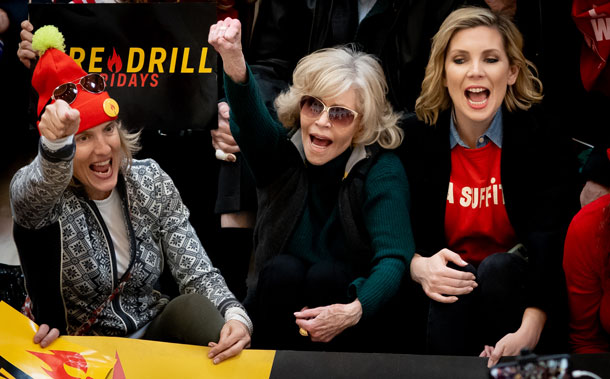
Jane Fonda with June Diane Raphael, her onscreen daughter in the Netflix show Grace and Frankie, to her left. (Photo: Victoria Pickering, Flickr, CC BY-NC-ND 2.0)
FONDA: I think that we have to honor and respect and acknowledge the men and women who helped develop the progress that created this country in a way, the people who sacrificed their health, sometimes their lives, but who spent their lives, providing us with the energy that has fueled progress. And that's why I like the Green New Deal because it says that in the transition from a fossil fuel economy to a clean energy economy, we have to make sure that those men and women are protected, not just trained for new jobs. But while they're being trained, paid union wages, and that the jobs they have pay union wages with good benefits, good pensions that can support them and their families and their communities can thrive again. We can see very clearly what happens when there aren't fair transitions. You mentioned the coal miners, look at what's happening to the former coal miners in the parts of Kentucky and West Virginia where the mines have closed down. There hasn't been a transition. Nobody's even paid any attention to them. They're suffering from black lung and other health problems and their health benefits have been cut. So that's example of what we cannot let happen. The fossil fuel that must be left in the ground is called stranded assets. The workers must never be stranded assets.
CURWOOD: So what do you see as the major obstacles to sufficient action on, on the question of the climate here in the United States.
FONDA: I think number one that people don't understand yet quite enough about the consensus among the scientists. When they do, they tend to stop thinking there's two sides to the story. The fact is, I just found out from a Yale scientist the other day, who studies public perceptions of climate change, there are 25 million people in this country who care enough that they're actually alarmed about the climate crisis, but they're not organized. Why? Because nobody's asked them. So that's a gauntlet thrown at the feet of organizers. We just have to organize. You know, the NRA only has 4 million members, but they're organized. If we can organize the people who do care about this issue, we will win.
CURWOOD: So Jane Fonda, are you going to help organize these people?
FONDA: That's what I'm going to devote the rest of my life [LAUGHS], it's going to be pretty short, but I'm going to do what I can to help organize the people that are needed. The scientists and experts say you only need 3.5% of the population to make policy changes.
CURWOOD: So that's about 9 million people or so, 10 million people could do this.
FONDA: Yeah. But we know that more than that are caring, we just have to get to them.
CURWOOD: What's your big message for the people of your generation on climate disruption?
FONDA: We can't let the young people shoulder the, the burden alone. They are understandably angry and upset that their future has been compromised and maybe even destroyed, the possibility of a living future. And they're angry and they're organized and they're demonstrating, but they're saying we didn't cause this to happen. Join us. So, that's what we're doing. We're saying now us adults, us grandmas in particular, have to, have to join and play our part. It's not our fault that it happened either. It's the fault of the fossil fuel industry, not the workers, but the industry. But, now that we know, we have to do something about it.
CURWOOD: What are we not talking about yet, when it comes to the climate, Jane?
FONDA: Well we're not talking about the climate crisis enough. We're just not talking about it enough. We have to, you know, it's like taxes and religion. People think, well, we can't talk about it at the dinner table, or over Thanksgiving dinner. But let's try. You know, even Uncle Joe who maybe voted for Trump thinks about the grandchildren, thinks about the future, maybe he can be made to care. Just try talking to people about it. Everyone, people in your office, people in the streets, your neighbors, your family. It has to become a topic of conversation. It has to become the norm for us to know this. You know, it's like sitting in a meeting room in your office. There was a time when everyone was smoking, and everybody thought it was normal. Imagine if somebody lit up a cigarette in, in one of those rooms now, they'd be a pariah. Look at that change, that cultural change that happened. We have to cause that cultural change to happen in the context of the climate crisis. Everyone has to be aware of it. Everyone has to be thinking about what they can do, both as individuals and in concert with other people to turn it around.
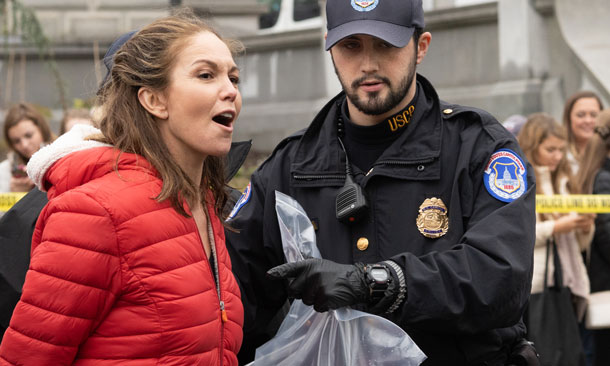
Actress Diane Lane being arrested at the Fire Drill Friday protests. (Photo: Victoria Pickering, Flickr, CC BY-NC-ND 2.0)
CURWOOD: Now, if Bill McKibben were with us, he would point out that we've had a bipartisan agreement in Washington, apparently, over these many years that we've known about climate disruption, to not do anything that would really turn things around. You're there in Washington, what signs do you see that the political system is getting responsive to this, getting responsive enough to the climate crisis?
FONDA: Well, Nancy Pelosi in the middle of the impeachment has gone to Madrid to be part of the COP 25 conference on the Paris Climate Treaty, that's a good sign. I met recently with the Senate subcommittee on climate change. And of course, they are very involved in this and they like what we're doing. I'm not inside the halls of power to really be able to answer your question adequately. I think that there's a reason why the climate Senate Task Force said, keep doing what you're doing, build an army, they need pressure from the outside. There are people that care, including, you know, at least -- see I, I often canvas with an organization called Working America, I go door to door, Scranton, Pennsylvania most recently, and even among Republicans climate is becoming an issue.
CURWOOD: Do they recognize you when you knock on the door?
FONDA: No, they don't. I mean, they have occasionally when I've done it in Modesto, California. Sometimes they recognize me and then fortunately, it's a very positive reaction. But, most of the time they don't know who I am. No, because you know, if someone appears in a way that they're never expected. And there's not an entourage and there's no makeup or anything like that, people tend not to know.
CURWOOD: So, Jane, what's your vision for 2020? As we come now, to the beginning of another year…
FONDA: Mmhmm.
CURWOOD: What are you feeling? What do you thinking? What do you want to say?
FONDA: Activism has to be ramped up a hundred-fold this coming year. Everything hinges on the elections in this country. We have to elect people, not just the president, because every elected official can play some role in addressing the climate crisis. So we have to ramp up our activism. We have to learn as much as we can about the climate science. We have to figure out what we as individuals can do, not as individuals, but within organizations. Don't, don't try to do something on your own. Join organizations that are addressing climate change. Write to your elected officials, get out in the streets, talk to people, make sure that everybody knows that there's consensus among the scientists. There's not two sides to this question, the way the fossil fuel industry would, would like us to believe. You know, it's, they've hired the same people that the tobacco companies hired to sow confusion and doubt among people about the dangers of cigarettes. They're using the same tactics: Well there's two sides. And you know, it's, it works because to ask people to make changes that are difficult. Well, it's hard. And so if somebody is saying to you, you know, it's not really clear that you have to do that, of course, they're going to say, Okay, then I'm not, because it's hard to do.
CURWOOD: [LAUGHS] That's right.
FONDA: So we have to be real clear about the consensus among scientists. I intend to, I'm going back to Hollywood in January to film the last season of Grace and Frankie, but as much as I can, I'm going to continue with my activism including with Fire Drill Fridays. And, even through the election, no matter who gets elected, we have to hold their feet to the fire. You know, back in the ‘30s, Franklin Delano Roosevelt said to the people who were saying "you have to do something, you've got to start these programs that will help us get jobs and earn a living and support our family. You have to do this and this". He said, "I agree with you, now go out and make me do it". So we have to go out and make them do it. Because the task is, as I said before, herculean.
CURWOOD: Jane Fonda is an actor and activist. Thanks so much for taking the time with me today.
FONDA: Oh, thanks for having me. I really appreciate it.
Related links:
- Click here to learn more about Fire Drill Fridays
- The New York Times | "Jane Fonda at 81, Proudly Protesting and Going to Jail"
[MUSIC: Kim and Reggie Harris & Rabbi Jonathan Kligler, “What’s That I Hear” on Let My People Go, by Phil Ochs, Appleseed Recordings]
CURWOOD: Coming up, we’ll take a look beyond the headlines with Peter Dykstra. That’s just ahead on Living on Earth.
ANNOUNCER: Funding for Living on Earth comes from you, our listeners, and United Technologies, combining passion for science with engineering to create solutions designed for sustainability in aerospace, building industries, and food refrigeration. UTC companies such as Otis, Carrier, Pratt and Whitney, and UTC Aerospace systems are helping to move the world forward. You can learn more about United Technologies by tuning into the Race to Nine Billion podcast; listen at racetoninebillion.com.
[CUTAWAY MUSIC: Emerson, Lake, and Palmer, “Fanfare For the Common Man” by Aaron Copland]
Beyond the Headlines
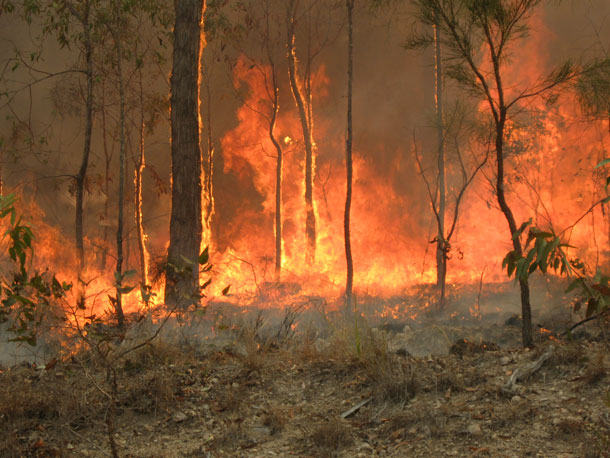
The Gosper’s Mountain Mega Blaze in Australia is 1,150 square miles across (Photo: 80 trading 24, Wikimedia Commons)
CURWOOD: It’s Living on Earth, I’m Steve Curwood.
The signs of a changing climate seem to be emerging more and more behind the headlines, so for the latest we are on the line now with Peter Dykstra, an editor for Environmental Health News, that’s EHN.org and DailyClimate.org. Hi Peter!
DYKSTRA: Hi Steve, how often do you hear the phrase 'fire is too big to put out' from firefighters? That's what they're saying about a huge bush fire outside of Australia's largest city, Sydney. They say that the city may be couched in smoke for months to come.
CURWOOD: That is not very good news. And of course, it's due to this massive drought over there.
DYKSTRA: We've seen pictures of the iconic Sydney Opera House, and the Sydney Harbour Bridge sort of covered in smoke. That's the most populous area of the country. And it's a very, very strong message that climate change is here to stay. And we're also looking at others from around the world.
CURWOOD: Okay, what do you have in mind?
DYKSTRA: In Bali, tourism Mecca in Indonesia, there's a combination of drought and the increase in tourism that are really doing a number on the water supply.
CURWOOD: So running out of water for tourists who want their long showers and then how do you grow food?
DYKSTRA: Growing food is part of it. And it's this inevitable clash between the tourist industry and tourists on one hand and the local residents on the other to get their day-to-day needs. But there's still another one from Africa.
CURWOOD: Okay, and what's that one?
DYKSTRA: Victoria Falls, another iconic tourist destination on the Zambezi River. More than half a mile long waterfall is running dry in a way that no one's ever seen before as a result of the worst drought in that area in a century.
CURWOOD: So is there no water going over the falls or is it just sort of . . . .
DYKSTRA: It's a trickle. There are some remarkable pictures where you see what used to be in what's normally this cascade of water stretched out over half a mile. It's now mostly barren cliffs with just a little stream heading over the falls.
CURWOOD: And I bet this isn't the last of things along these lines that you've noted.
DYKSTRA: There's one more unfortunately, we need to go to the Alps where it is winter and instead of the Southern Hemisphere summer, and winter, of course is ski season, and we're looking at an increasing number of closed and even abandoned ski resorts in the Alps, due to a decline in skiable days during the winter months.
CURWOOD: Signs of climate disruption everywhere. Hey Peter, what else do you have for us today?
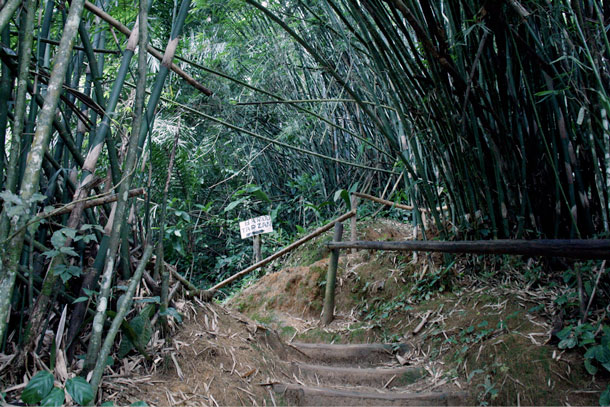
A drive-by shooting killed anti-logging activists Firmino Guajajara and Raimundo Guajajara and left two injured. (Photo: Claire Thibault, Pexels)
DYKSTRA: Well, here's something it seems we're mentioning this all the time. Unfortunately, we have to mention it again. Because last week, two more indigenous environmental activists, anti-logging activists, were murdered in what appears to be a drive-by shooting in the northeastern Brazilian state of Maranhao.
CURWOOD: Oh man, this is just happening way too much. I think last year 100 and, more than 160 environmental activists were killed. When will this stop do you think?
DYKSTRA: It's, I don't know that it's ever going to stop. There are still brave people who have obviously literally put their lives on the line.
CURWOOD: What do we have from the annals of history for today, Peter?
DYKSTRA: There's a 20th anniversary, and for me it's hard to believe that this is already 20 years ago. December 18, 1999, Julia Butterfly Hill came down from the tree she had been sitting in for more than two years, a Northern California Redwood that was slated for cutting.
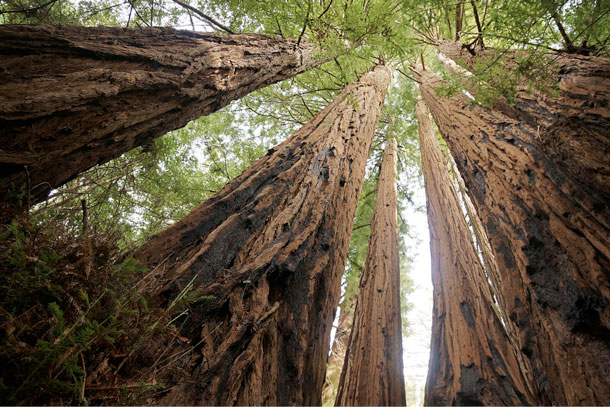
Julia Butterfly Hill lived in a nearly 200 foot tall California redwood dubbed ‘Luna’ for 738 days to draw attention to the plight of forests. (Photo: Allie Caulfiel, Wikimedia Commons, Public Domain)
CURWOOD: That tree, I believe, was called Luna.
DYKSTRA: Luna was the name given to the tree. There was an attempt to kill Luna out of spite. But as far as we know, the tree is still alive and well and growing and enormous. Something is different about Julia Butterfly Hill. Her website says she's "no longer available to discuss the epic tree sit, and that her life has moved on." I guess somebody that could deal with more than two years worth of absolute solitude may not want to deal with celebrity for the rest of her life.
CURWOOD: Who could blame her? Thanks, Peter. Peter Dykstra is an editor with Environmental Health News, that’s EHN.org and DailyClimate.org. We'll talk to you real soon, right after the holidays.
DYKSTRA: Well good to talk to you as always and happy holidays to you and happy holidays to everyone.
CURWOOD: And there's more on these stories at the Living on Earth website, LOE.org.
Related links:
- More information about the fire in Australia
- Learn about Subak, Bali’s irrigation system
- The Guardian | “Victoria Falls Dries to a Trickle After Worst Drought in a Century”
- The Guardian | “Seduced and Abandoned: Tourism and Climate Change in the Alps”
- Deutsche Welle | “Brazilian Indigenous Tribesmen Shot in Hit-and-Run Attack”
- Julia Butterfly Hill’s website
[BIRDNOTE THEME]
BirdNote®: Rock Sandpipers Are Tough
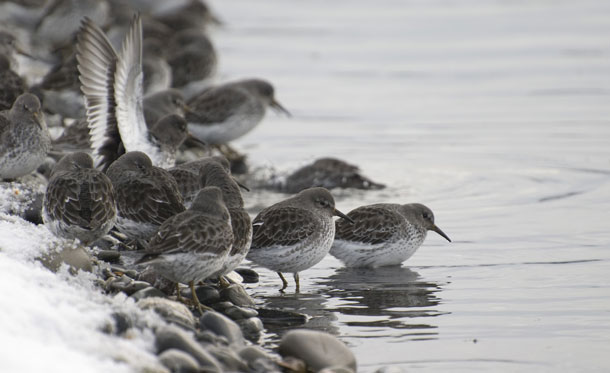
A colony of rock sandpipers sit on the shore. (Photo: © Aaron Lang)
CURWOOD: You’ve heard the expression ‘tough old bird’ I imagine. Well, it might just have been inspired by the Rock Sandpiper of Alaska. Here is Mary McCann with BirdNote.
BirdNote®
Rock Sandpipers Are Tough - Homer Spit Christmas Bird Count
[Waves crashing on rocky shore, wind howling]
Although the town of Homer is in southern Alaska, no one would ever think of it as southern on this midwinter day. The temperature is well below freezing, and flurries of snow dance in the blustery wind. This is a place for rugged birders and the even tougher birds they seek. [Rock Sandpiper calls]
So let’s put on heavy parkas and head onto Homer Spit, on the longest road into ocean waters anywhere in the world. We’ll watch in particular for Rock Sandpipers feeding along the gravelly shore. These small gray shorebirds run or walk this way and that, probing into the gravel and seaweed. Anything that moves is fair game, especially amphipods, the little crustaceans that hop about when exposed. But the birds also recognize clams, snails, and barnacles as tasty food. [Calls of Glaucous-winged Gulls]
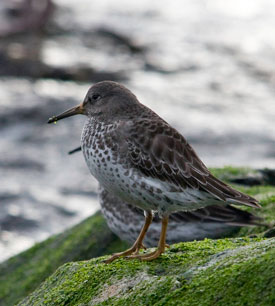
These small shorebirds like to eat small critters on the coast, like clams and crabs. (Photo: M.E. Sanseverino, CC)
Gulls, waterfowl, and many other birds forage along the spit, but Rock Sandpipers are the only shorebirds. [Calls of Rock Sandpipers] Their dense feather coat extends down their legs almost to the ankle, affording some protection from the cold. [Calls of Rock Sandpipers]
How do we know exactly which birds winter on Homer Spit? Well, one way is through the annual Christmas Bird Count sponsored by National Audubon. These counts go on all over the country. You don’t have to be an expert to join one – just bring your binoculars and your curiosity. To find one near you, begin at birdnote.org.
###
Written by Dennis Paulson
Bird sounds provided by The Macaulay Library of Natural Sounds at the Cornell Lab of Ornithology, Ithaca, New York. Rock Sandpiper [63777] recorded by W.W.H. Gunn; Glaucous-winged Gull [3350] by A.A. Allen.
BirdNote’s theme music was composed and played by Nancy Rumbel and John Kessler.
Waves recorded by Kessler Productions
Producer: John Kessler
Executive Producer: Chris Peterson
© 2015 Tune In to Nature.org December 2014/2017/2019 Narrator: Mary McCann
ID# ROSA-01-2012-12-17 ROSA-01
https://www.birdnote.org/show/rock-sandpipers-are-tough
CURWOOD: For pictures of these tough birds, go to the Living on Earth website, LOE.org.
Related links:
- Hear this story on the BirdNote website
- Learn about rock sandpipers at the Cornell University All About Birds website
A Preschool Christmas Bird Count
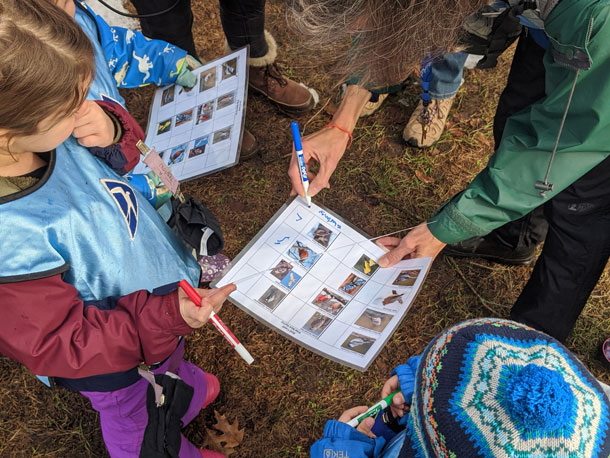
Susan Richmond helps her students tally off sightings from a list of common local birds. (Photo: Isaac Merson)
So we thought we would check out the Christmas Bird Count at the Massachusetts Audubon Society, which has been hosting one since 1900, even before the National Audubon Society was formally established in 1905. The key notion is to count every bird you see in the course of a day in a particular area. Many consider it to be the largest citizen science project in the world with close to 80,000 people expected to participate this year between December 14th and January 5th. And now there is a children’s book about the Christmas Bird Count, written by Mass Audubon’s pre-school teacher, Susan Richmond. Living on Earth’s Bobby Bascomb met up with Susan and some of her students at Mass Audubon’s Drumlin Farm in Lincoln near Boston to do a bit of birding and check out her book.
[SOUNDS OF KIDS AT CIRCLE TIME]
BASCOMB: Susan Richmond is seated in a wooden child sized chair in front of a massive stone fireplace. Her 13 preschool students fan out in front of her in a half moon as she reads from her book…..
[SOUND OF PAGE TURNING]
RICHMOND: I shake mom in the dark. Wake up sleepy head, it’s bird count day!
BASCOMB: Her story follows a little girl named Ava out on a bird count with her mom and their group leader Big Al. The book goes over the basic rules. Each bird has to be seen by at least two people, you can’t count the same bird twice, and you must keep a tally of the birds you see as you go.
RICHMOND: Our team follows the same route every year. Fields, woods, wetlands, neighborhoods, even the center of town. A chickadee calls good morning. Chic-a-dee-dee-dee. I add it to the list, I’m going to be busy today.
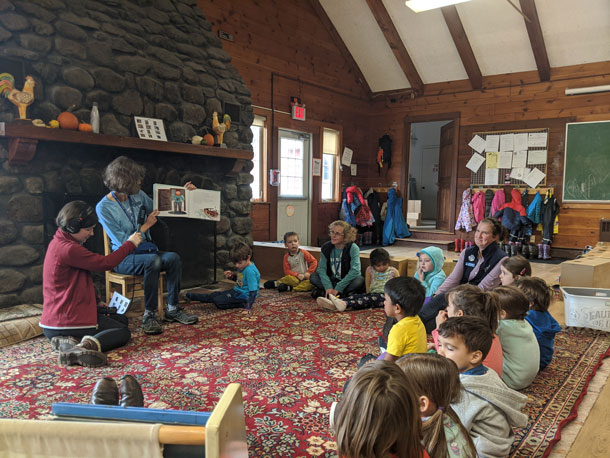
Susan reading her book Bird Count aloud to her class. (Photo: Isaac Merson)
[KID SOUNDS]
BASCOMB: Once they finish the book the kids have a snack and get ready to go outside and I chat with Susan about her inspiration for the book.
RICHMOND: I am a passionate birder, like, I love birding. So it was sort of a natural topic for me. I think one of the reasons that I love birds so much is because they are everywhere. I mean, even the city, you can count starlings and house sparrows and the occasional peregrine falcon or you know, maybe you will find something like a song sparrow, but it doesn't matter. Like every bird is important. It's really this treasure hunt. It's very exciting.
BASCOMB: With 120 years of data from across the Western Hemisphere, the Christmas Bird Count has yielded a massive data set that already documents changes in bird distribution.
RICHMOND: So it's become a really valuable tool for ornithologists to study all kinds of things, effects of climate change on bird populations, as well as development, pollution and all kinds of other factors. I mean, they have definitely seen, been able to track things like the birds that used to be only in the southern part of the United States, for example, I mean, people don't understand that a cardinal actually used to be a southern bird. Now it seems sort of the quintessential Christmas bird against the snowy background on the Christmas card. But actually, they used to be, I can't tell you how many years ago but they were typically a southern species. So we've seen that that in response to changing climate patterns.

Preschool director Jill Canelli plays a game to teach students to identify local birds. (Photo: Isaac Merson)
BASCOMB: In the North, winter is a good time for novice birders to get out and look for birds. There are few migrating birds around to misidentify.
RICHMOND: Most of the birds that you're going to see in the winter are the resident birds that you see all year. So, you know, you might occasionally see something unusual like a snow bunting or a Ruby crowned kinglet or something but hopefully there might be someone on the team who can help you with that.
BASCOMB: Huge surveys like this wouldn’t be possible without volunteers, so citizen scientists are a valuable resource. Plus, birding is great way for children to engage with nature.
RICHMOND: I feel like the most important thing to do at this age, at the age of three, four or five or two, is to have them connected with their immediate environment, to love not just nature as an abstract concept or love seeing beautiful pictures of nature but actually love their environment and, and become invested in it and care about it because that's what's going to make them want to protect it when they grow up.
[SOUNDS OF KIDS GETTING DRESSED TO GO OUT]
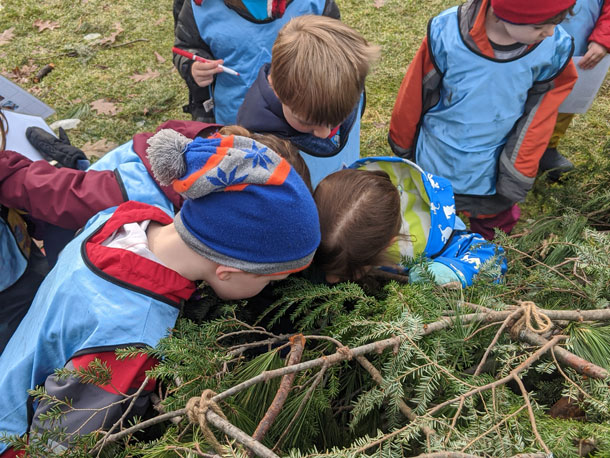
Students investigate a habitat being built for wildlife at Drumlin Farm. (Photo: Isaac Merson)
BASCOMB: Snack time is over for the children so they suit up and head outside. Donning rubber boots, brightly colored rain pants and jackets the kids head out into an unseasonably warm December day.
[KIDS TROMPING OUTSIDE]
They are armed with a laminated page showing pictures of the dozen birds we are likely to see and a dry erase marker so they can mark them off.
[CRUNCHING THROUGH SNOW / SPLASHING THROUGH PUDDLES]
BASCOMB: The kids crunch through what’s left of a recent snow and stomp in mud puddles. Before long…
RICHMOND: I did hear a chick-a-dee-dee-dee, did anyone hear that?
KID 1: Mm-hmm.
KID 2: Me too!
RICHMOND: So you can make a mark, because we heard it.
[KIDS STOMPING THROUGH SNOW, PUDDLE SOUNDS]
BASCOMB: Hi! What kind of bird do you want to see today?
DANNY: A… blue jay.
BASCOMB: A blue jay? Why do you want to see a blue jay?
DANNY: Um, because… um, I like how they fly.
BASCOMB: Some kids are poking around in the snow and mud while others strain their eyes and ears for birds.
TEACHER: House sparrows, yes! Three house sparrows over there. And Milo saw them too, so that means we can add them, because two people saw them.
BASCOMB: But it’s not always easy to identify birds from a distance.
RICHMOND: Oh, I do see them! Friends, come over here, I see some birds in trees. It’s hard to tell what they are… big black birds.
LEO: Crows!
RICHMOND: They, they could be crows, Leo; they look, I don’t know if they’re big enough for crows.
KID: I think they’re a kind of hawk.
RICHMOND: Hmm. . . . Ah. I think they’re starlings. Which is not on our list, but we can add them. Shall we add them, Danny?
DANNY: Yeah.
KID: Can you add it to mine, too?
RICHMOND: Sure. Starlings… ‘cause starlings are all black.
KID: Can you add a starling to me?
RICHMOND: Mmhmm. And we saw two, two starlings.
BASCOMB: And then, a chance to visit birds of a different feather.
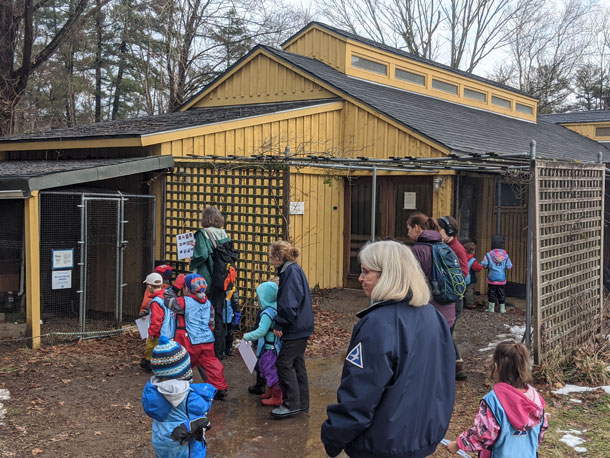
The students take a trip down to the chicken barn to help out with the daily chicken chores. (Photo: Isaac Merson)
[ROOSTER CROWS / HENS CLUCKING]
BASCOMB: Drumlin farm is home to dozens of chickens, of many different breeds. And today the children have to do their chicken chores in the hen house. They collect any eggs the hens have laid, and make sure they’re well-fed. A few are afraid of the loud sounds but most kids are jostling to feed the fowl.
RICHMOND: Theo, Benjamin, Rivka, do you want to feed the chickens? Let me give you a little food.
[SOUND OF FOOD PELLETS]
[HENS CLUCKING IN BACKGROUND]
RICHMOND: Did you find any eggs?
KID: One’s still laying eggs so we have to wait to get ‘em.
RICHMOND: Okay, let’s go on to the next one. Can you put your container back? Thank you.
[SOUNDS OF KIDS TROOPING OUT OF THE HENHOUSE]
BASCOMB: Soon the flock of preschoolers heads back up the path.
[SOUNDS OF GROUP WALKING ON THE PATH]
BASCOMB: Today’s birding has been an informal session, kind of a practice run. But I asked the kids if they would like to do a real Christmas Bird Count like Ava in the book.
KIDS: Meeeee!!
KID: I do!
BASCOMB: Why do you want to do one?
KID: ‘Cause it’s so fun!
BASCOMB: Yeah, what’s fun about it?
KID: Um, the birds!
BASCOMB: Seeing the birds? Did you say you want to do one, Danny? What do you think, what would be so fun about it?
DANNY: Um, because I like birds.
BASCOMB: What do you like about birds?
DANNY: Um, that they have soft feathers.
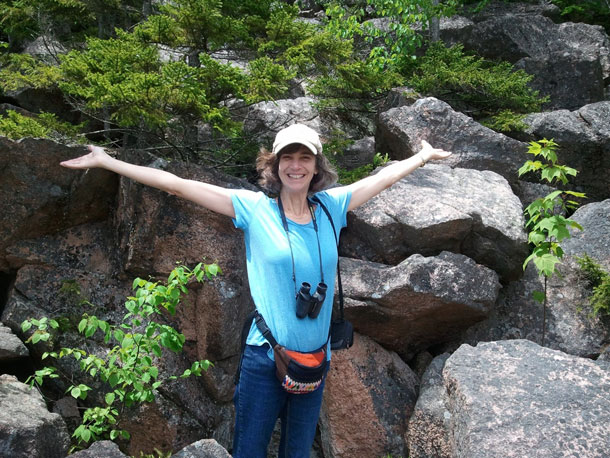
Susan Edwards Richmond teaches at an environmental preschool program at Drumlin Farm, a Massachusetts Audubon wildlife sanctuary in Eastern Massachusetts. (Photo: Courtesy of Susan Edwards Richmond)
BASCOMB: The national Audubon’s Christmas Bird Count takes place December 14 through January 5. There are roughly 2500 events listed online, probably one near you, and it’s fun for the whole family.
[KIDS PLAYING IN THE SNOW, HAVING FUN]
BASCOMB: For Living on Earth, I’m Bobby Bascomb in Lincoln, Massachusetts.
CURWOOD: Our story about the Christmas Bird Count was produced by Jenni Doering with help from Isaac Merson.
[KIDS PLAYING IN THE SNOW, HAVING FUN]
Related links:
- Read more about Susan’s work, and the book Bird Count here
- Click here to learn more about the Christmas Bird Count and find one near you
- About Drumlin Farm Community Preschool
[MUSIC: Joshua Messick, “Autumn Rain”]
CURWOOD: Living on Earth is produced by the World Media Foundation.
Our crew includes Naomi Arenberg, Bobby Bascomb, Paloma Beltran, Thurston Briscoe, Jenni Doering, Jay Feinstein, Merlin Haxhiymeri, Don Lyman, Isaac Merson, Aynsley O’Neill, Jake Rego, Anna Saldinger, and Jolanda Omari.
Tom Tiger engineered our show. And we bid farewell to Lizz Malloy - thanks for your wholesome presence. Alison Lirish Dean composed our themes. You can hear us anytime at L-O-E dot org, iTunes and Google play- and like us, please, on our Facebook page. We tweet from @livingonearth. You can find us on Instagram at livingonearthradio. I’m Steve Curwood. Thanks for listening!
ANNOUNCER: Funding for Living on Earth comes from you, our listeners, and from the University of Massachusetts, Boston, in association with its School for the Environment, developing the next generation of environmental leaders. And from the Grantham Foundation for the protection of the environment, supporting strategic communications and collaboration in solving the world’s most pressing environmental problems. Support also comes from the Energy Foundation, serving the public interest by helping to build a strong, clean, energy economy.
ANNOUNCER 2: PRX.
Living on Earth wants to hear from you!
Living on Earth
62 Calef Highway, Suite 212
Lee, NH 03861
Telephone: 617-287-4121
E-mail: comments@loe.org
Newsletter [Click here]
Donate to Living on Earth!
Living on Earth is an independent media program and relies entirely on contributions from listeners and institutions supporting public service. Please donate now to preserve an independent environmental voice.
NewsletterLiving on Earth offers a weekly delivery of the show's rundown to your mailbox. Sign up for our newsletter today!
 Sailors For The Sea: Be the change you want to sea.
Sailors For The Sea: Be the change you want to sea.
 The Grantham Foundation for the Protection of the Environment: Committed to protecting and improving the health of the global environment.
The Grantham Foundation for the Protection of the Environment: Committed to protecting and improving the health of the global environment.
 Contribute to Living on Earth and receive, as our gift to you, an archival print of one of Mark Seth Lender's extraordinary wildlife photographs. Follow the link to see Mark's current collection of photographs.
Contribute to Living on Earth and receive, as our gift to you, an archival print of one of Mark Seth Lender's extraordinary wildlife photographs. Follow the link to see Mark's current collection of photographs.
 Buy a signed copy of Mark Seth Lender's book Smeagull the Seagull & support Living on Earth
Buy a signed copy of Mark Seth Lender's book Smeagull the Seagull & support Living on Earth

